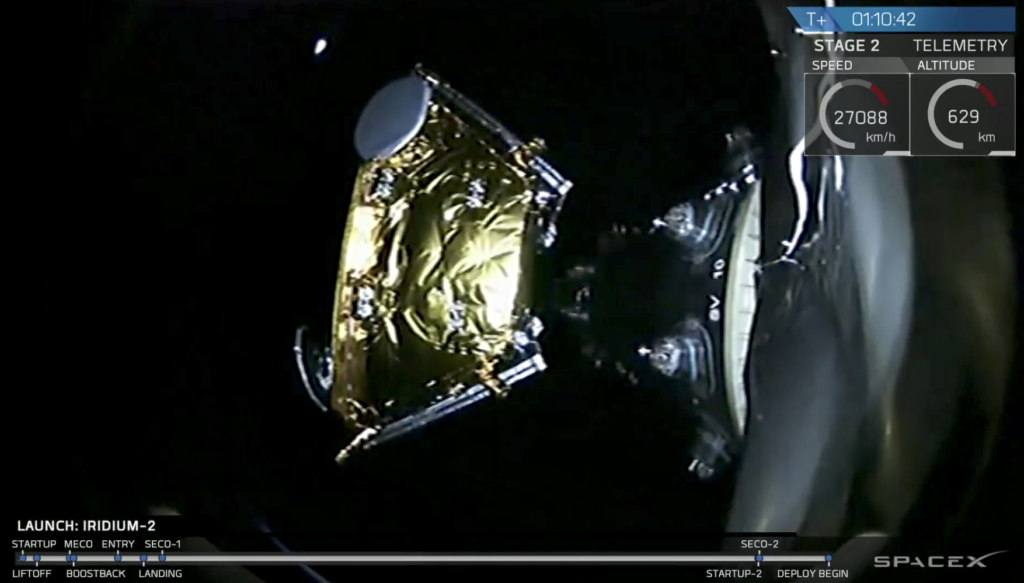
It has been a busy month for space fans.
June began with the launch of ViaSat-2, the "world's most powerful" internet communications satellite.
And yesterday afternoon there was another major launch destined to expand the potential for staying connected anywhere on the globe:
The launch of the second set of ten satellites in the Iridium NEXT constellation.
There have also been new developments this month from OneWeb and HughesNet - and we'll even share the latest on SpaceX's future plans.
Satellite internet options available now and coming in the years ahead are looking more exciting all the time!
Table of Contents
Iridium Upgrades Underway

Iridium is in the midst of a massive upgrade of the Iridium constellation, which first launched between 1997 and 2002.
Unlike geostationary satellites (like ViaSat and HughesNet) which are fixed in place 22,236 miles above the equator - low-earth-orbit (LEO) constellations like Iridium are placed in much lower polar orbits so that at least one satellite in the swarm is always passing overhead.
By being so much closer to the surface, the need for cumbersome precisely aimed dish antennas is eliminated - and the latency impacts caused by the speed-of-light travel time is vastly diminished as well.
Iridium is best known for providing global satellite voice phone service, but with the new generation of satellites Iridium will be able to roll out a advanced data capabilities well beyond what was possible before.
Iridium CEO Matt Desch explained:
"Right now, it's two down with six more launches to go. Our operations team is eagerly awaiting this new batch of satellites and is ready to begin the testing and validation process. After several weeks of fine-tuning, the next set of ‘slot swaps' will begin, bringing more Iridium NEXT satellites into operational service, and bringing us closer to an exciting new era for our network, company, and partners."
The next ten Iridium NEXT satellites are slated to launch sometime in August, and if all continues to go according to plan the entire 75 satellite constellation (66 active and 9 spares) will have been upgraded by early 2018.
The Iridium NEXT system will offer "speeds from 22 kbps and eventually all the way up to 1.4 Mbps once fully deployed" - painfully slow by LTE cellular standards, but an order of magnitude faster than what is possible with the current generation of affordable global coverage Iridium technology.

OneWeb Gets a Green Light

We first wrote about OneWeb back in 2015, when it announced plans to begin work on "building the world's largest constellation of satellites" with over 700 satellites in the swarm.
OneWeb has had few updates to share since, but last week announced a major milestone - it had just received FCC approval to move forward with (literally) launching OneWeb service in the American market.
OneWeb Founder Greg Wyler shared:
"The FCC’s decision today, to grant market access to OneWeb, is an important step in helping to bring much needed low latency broadband access to Americans living in remote and hard to serve areas. OneWeb was founded with the mission to bridge the global digital divide and will begin services in Alaska as early as 2019."
This makes OneWeb the first next-generation satellite system to get a legal green-light to begin deploying service.

The proposed OneWeb network will consist of 720 satellites in low orbit only 750 miles above the earth, substantially dwarfing Iridium in scale and speed.
OneWeb claims it will be able to support 50Mbs speeds, and 30ms latency - a huge improvement over the 600ms latencies common with geosynchronous satellite systems.
The first OneWeb satellites are entering production now, and the first of the many launches necessary to lift the swarm into orbit will begin in early 2018.
If all goes according to plan, in 2019 many areas of Alaska and Canada may gain access to low-latency broadband speeds for the first time ever, and as the remainder of the swarm launches and comes online OneWeb will be able to start offering services at lower latitudes too.
SpaceX Swarm Expands Massively

In addition to providing launch services to Iridium, SpaceX has also been working on a massive satellite communications network of its own - first announced in 2015, and detailed in FCC filings last November.
In November what SpaceX revealed was plans for an 800 satellite preliminary swarm that would then be fleshed out to 1,600 satellites for the initial deployment phase.
The next phase of the ramp-up would add an additional 2,825 satellites - bringing a total of 4,425 operational satellites online to enable high bandwidth (up to 1Gbps!) and low latency (25ms claimed) service anywhere on earth
It sounds amazing - particularly when you consider that there are currently estimated to be only 1,459 operational satellites in orbit.
SpaceX aims to have triple that, in one network alone!

Or at least that's what SpaceX proposed in November.
In a more recent FCC filing in March, SpaceX revealed that it intends to launch an additional very-low-earth-orbit (VLEO) constellation consisting of 7,518 (!!!) satellites orbiting just 210 miles above the surface to bring online additional network capacity.
It sounds like an insane plan, but SpaceX makes its ambitions clear:
"These assets, referred to herein as the “VLEO Constellation,” would enhance capacity where it may be needed most, enabling the provision of high speed, high bandwidth, low latency broadband services that are truly competitive with terrestrial alternatives."
Amazing! But when?
SpaceX VP of Satellite Government Affairs Patricia Cooper testified recently to congress:
"Later this year, SpaceX will begin the process of testing the satellites themselves, launching one prototype before the end of the year and another during the early months of 2018. Following successful demonstration of the technology, SpaceX intends to begin the operational satellite launch campaign in 2019. The remaining satellites in the constellation will be launched in phases through 2024, when the system will reach full capacity with the Ka- and Ku-Band satellites."
If SpaceX can come even close to delivering on this vision, it will revolutionize global communications.
SpaceX hopes to use the income from the internet service to fund construction of future Mar's colony ships.
Yes - we are living in a world where Sci-Fi is becoming increasingly real. *grin*
HughesNet Gen-5 - Today's Best Bet

Iridium and ViaSat's next generation services are coming in 2018, OneWeb's first commercial service will roll out in 2019, and SpaceX is currently on target for widespread commercial service not much sooner than 2020.
If you want a satellite internet option available today - the new HughesNet Gen5 system is proving itself with several RVers now reporting great experiences with mobile-enabled Gen5 service.
Yes - HughesNet has an awful reputation from past overload satellites and customer service nightmares, but Gen5 is an entirely new satellite with much improved technology over what came before.
Do keep in mind - HughesNet primarily intends their service to be professionally configured fixed residential installations, and if you do have normal HughesNet Gen5 service it will NOT connect to the satellite if you take it more than 50-100 miles away from your provisioned home spot-beam service area - no matter how much time you spend aiming the dish.
But truly mobile Gen5 service IS possible - if you work with a reseller that is set up to offer it.

The experts in this for the RV market is MobileInternetSatellite.com - they specialize in providing the tripod-based portable systems and the special mobile provisioned plans, as well as the training in manually aiming and configuring your system at each location you stop at.
MIA member Per Mogensen this week shared his experiences with his new Gen5 tripod system:
"Got our HughesNet Gen 5 satellite and got all setup. The first two times took a long time until getting the hang of aiming the dish. The third time took 20 minutes for setup, aiming and configuration. It works for what I have tried. No online gaming of course. I was very skeptical too since I do a lot of online meetings and use the phone for sound. But the delay is not bad - noticeable but not impossible."
He made this video showing off his great surfing experience in the middle of nowhere, connected via HughesNet Gen5:
The downside of HughesNet Gen5 service is the big awkward dish that requires manual setup at every stop - and the lack of any sort of truly unlimited data plan.
But if you are willing to work around the frustrations, limitations, and the ever-present latency - there is something absolutely magical about being online far away from even a remote hint of cellular.
Check out our review center page for more details and pricing information on the HughesNet Gen5 service:
HughesNet Gen5 Spot Beam Service
Further Reading & Viewing:
Our video update on satellite internet:
For those interested in RV-friendly satellite internet options, in January we hosted a member webinar overviewing the topic and published an updated in-depth guide here:








 Mobile Internet Resource Center (dba Two Steps Beyond LLC) is founded by Chris & Cherie of
Mobile Internet Resource Center (dba Two Steps Beyond LLC) is founded by Chris & Cherie of